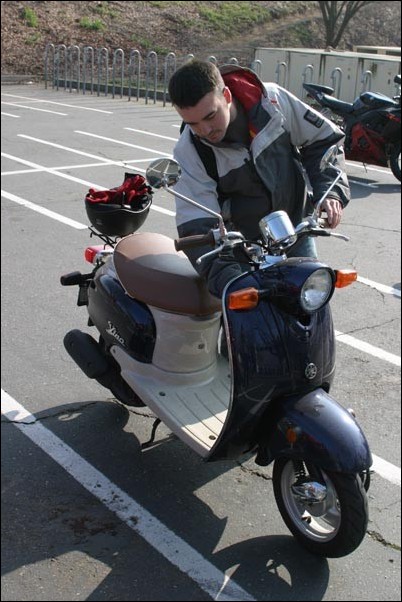Two-wheel advantage
Image: Two-wheel advantage:Junior Denton Ward prepares to ride his Vespa out of the parking lot adjacent to the Hornet Bookstore.:Tojo Adrianarow/State Hornet
February 16, 2005
The coming of spring means changes for everybody, but it&s especially important to students who ride motorcycles.
Warmer weather and less rain means conditions that are ideal for people who enjoy the carefree lifestyle of riding a motorcycle.
At Sacramento State, the rows of vastly different years, makes, models and styles of motorcycles in the parking lot are a testament to the changing season.
Riding a motorcycle to campus can be a lot of fun. While the fun factor is the main reason most motorcyclists choose their particular method of commute, there are additional benefits to riding to school.
&I save an hour of time,& said Sac State senior Matt Balvin, who rides his Honda CBR 954 motorcycle to campus. &I can use carpool lanes and I never have to look for parking.&
The small amount of space it takes to park a motorcycle means more of them can fit into a smaller area than cars require. The two-wheeled vehicle parking lot across from the Hornet Bookstore has 142 spaces. A parking lot with twice the area of the two-wheeled vehicle lot couldn&t hold as many cars.
Motorcycle parking permits are also cheaper. They cost $26.50 per semester, whereas a car permit costs $108.
As gasoline prices increase, the cost of commuting can become a real burden on students with a fixed income. Most motorcycles average between 40 to 50 miles per gallon. Scooters can get as much as 100 mpg.
Another benefit to riding a motorcycle is that traffic doesn&t have to be as much of a problem.
&It&s a lot faster when you can ride between lanes,& senior Chai Saephan said. &I don&t have to sit in traffic.&
According to the California Motorcycle Handbook, lane splitting (riding between rows of slow-moving cars) is legal in the state. While the handbook considers the practice dangerous, it can be an effective way to reduce commute times significantly.
Like any method of transportation, commuting by motorcycle has some disadvantages. Being smaller can help to maneuver through traffic, but it also makes motorcycles hard to see, increasing the chances of an accident.
According to the Motorcycle Safety Foundation, lack of visibility is a leading cause of accidents between cars and motorcycles.
Motorcycles also lack the structural protection that a car offers. This means that there is nothing between the rider and a pavement besides clothing and a helmet. Accidents that leave drivers of cars with a minor case of whiplash can mean much more serious injuries to motorcyclists.
The added risk to personal safety is something that anybody who would like to learn to ride a motorcycle has to consider, and is one reason the lifestyle isn&t for everybody.
Anybody interested in learning to ride a motorcycle can obtain a copy of the California Motorcycle Handbook from the local DMV. The handbook provides information about safety and choosing a motorcycle, as well as obtaining a license.
The Motorcycle Safety Foundation also has similar information and offers a safety course that waives the road test requirement for obtaining a license.










































































































































